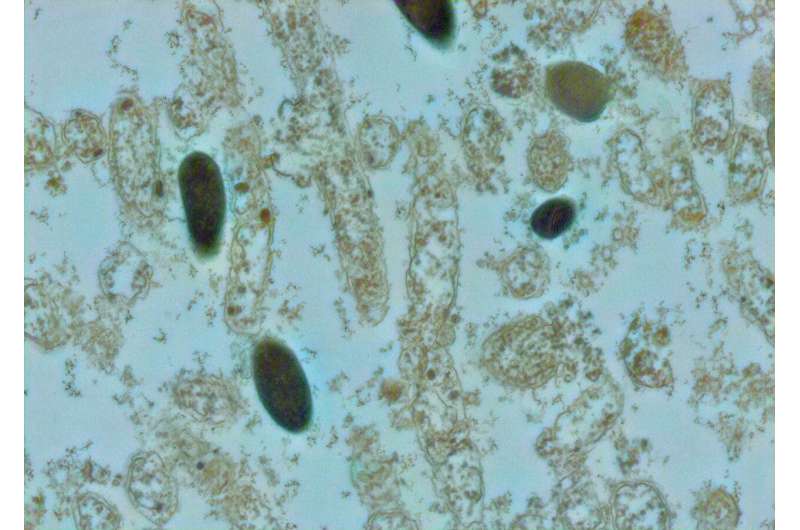This article has been reviewed according to Science X's editorial process and policies. Editors have highlighted the following attributes while ensuring the content's credibility:
fact-checked
peer-reviewed publication
trusted source
proofread
A common fatty acid may help restore healthy vaginal bacteria after infection

More than half of women globally experience bacterial vaginosis (BV)—an imbalance of naturally occurring microbes in the female genital tract—at least once in their life. The condition can cause painful symptoms and vaginal discharge, and although treatable with antibiotics, it frequently comes back within a short time. If left untreated, BV can lead to problems with pregnancy and an increased risk of sexually transmitted infections, including HIV.
A team of researchers at the Broad Institute of MIT and Harvard; the Ragon Institute of Mass General Brigham, MIT, and Harvard; and St. Jude Children's Research Hospital has discovered that oleic acid, one of the most abundant fatty acids in the body, restores a healthy balance of vaginal microbes in a laboratory model of BV.
Their findings, published in Cell, demonstrate that oleic acid and several other unsaturated long-chain fatty acids (uLCFAs), which are critical components of cell membranes and can have antimicrobial properties, simultaneously inhibit the growth of vaginal microbes associated with negative health effects and promote other species associated with a healthier female genital tract.
Treatments that promote this balance of microbes could one day help prevent repeat vaginal infections in people.
"Current treatment methods work as well as a coinflip, and that hasn't changed in more than 40 years of medical practice, so new methods are needed to help patients," said first author Meilin Zhu, who recently graduated with a Ph.D. from the labs of Paul Blainey, a Broad core institute member and MIT professor, and Doug Kwon, a core member of the Ragon Institute, associate professor of medicine at Harvard Medical School, and an infectious disease physician at the Massachusetts General Hospital, both co-senior authors on the paper.
"I'm so proud of this team and the partnership we formed to follow the science and set up some major positive impacts on women's health," Blainey said. "This is an amazing story of keen observation, serendipitous discovery, and the hard work that real scientific rigor demands."
Metabolic differences
The human female genital tract is naturally colonized by microbial species in the Lactobacillus genus. Treating BV with antibiotics can shift the balance of lactobacilli toward an overabundance of Lactobacillus iners, a bacterial species that creates an environment that is more susceptible to BV recurrence.
Zhu sought methods of promoting Lactobacillus crispatus, a species that creates a more stable microbiome than L. iners. She planned to use a large-scale screen developed in the Blainey lab to study the impacts of different compounds on the bacteria.
But Zhu discovered an important clue even before she began the screening. A component of the culture medium used to grow lactobacilli in the lab was disrupting the screening tool, but the bacteria would not grow in culture without it. While troubleshooting the issue, Zhu found that many of the lactobacilli required an ingredient in the medium—oleic acid—to thrive.
When she cultured different strains of lactobacilli with oleic acid, she found that oleic acid inhibited growth of L. iners, the detrimental bacteria, and simultaneously promoted the growth of strains associated with healthier microbiota such as L. crispatus.
Using RNA sequencing and working with the Broad's Metabolomics Platform and collaborators at St. Jude's, the team identified a group of genes involved in processing uLCFAs that are present only in the non-Lactobacillus iners species.
One of these genes encodes the enzyme oleate hydratase, which sequesters uLCFAs, a scarce resource, into a form only bacteria with this enzyme can use. Another of the genes encodes a fatty acid efflux pump that is necessary for bacteria to withstand high concentrations of oleic acid.
"We used state-of-the-art genetics tools that a lot of researchers in vaginal microbiology haven't had access to, even though they're the gold standard for any mechanistic study," Zhu said. "It's a good step forward for the field." She added that the field of vaginal microbiology does not receive the same resources as other areas of microbiology.
The team also modeled how oleic acid might affect the vaginal microbiome of BV patients by culturing bacteria associated with BV together with L. iners and L. crispatus. Oleic acid effectively inhibited growth of L. iners as well as most BV-associated bacteria, including some strains resistant to standard antibiotic treatment. This indicates oleic acid may be an effective way to restore a stable, healthy microbiome in the female genital tract after BV.
"This study is an important example of how understanding core metabolic requirements and functions of key bacteria can lead directly to new therapies that allow us to modify the microbiome for improved health," said co-senior author Seth Bloom, an infectious diseases instructor at the Massachusetts General Hospital.
At the Ragon Institute, Kwon's lab is working to move this research toward a human clinical trial.
"We believe there is exciting potential to translate these findings to durably alter the vaginal microbiome to improve BV treatment and reduce adverse health outcomes for women globally," Kwon said.
More information: Vaginal Lactobacillus fatty acid response mechanisms reveal a metabolite-targeted strategy for bacterial vaginosis treatment, Cell (2024). DOI: 10.1016/j.cell.2024.07.029. www.cell.com/cell/fulltext/S0092-8674(24)00823-7




















